” If Santa was real, what would he have done in the war?” Benjamin Dickson and Gavin Mitchell, on the ultimate good vs evil battle in Santa Claus vs. The Nazis
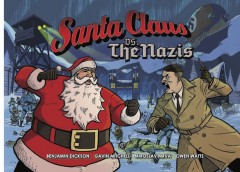 Originally seen in the pages of Aces Weekly, Benjamin Dickson and Gavin Mitchell’s seasonal action adventure Santa Claus vs. The Nazis is about to get a new print release courtesy of the folk at Markosia. Even though we’re a couple of months early for St Nick’s Big Day, we managed caught up with Ben and Gavin to talk about the ultimate battle between good and evil!
Originally seen in the pages of Aces Weekly, Benjamin Dickson and Gavin Mitchell’s seasonal action adventure Santa Claus vs. The Nazis is about to get a new print release courtesy of the folk at Markosia. Even though we’re a couple of months early for St Nick’s Big Day, we managed caught up with Ben and Gavin to talk about the ultimate battle between good and evil!
Tell us a bit about the idea behind Santa Claus vs The Nazis – was it as simple as trying to find the ultimate good guy to take on the ultimate bad guy?
Benjamin Dickson: It was simply a question that popped into my head one Christmas: If Santa Claus was real, what would he have done in the war? The idea of Santa Claus fighting Nazis made me laugh, so it stuck. I was really unsure if it would work or not – after all, the movie “Santa Claus Conquers The Martians” is a great title, but it’s not a great film. But I started developing the concept in my head anyway, like you do with ideas that won’t go away. The real fun of developing it was taking elements of Christmas folklore, putting them in the real world circa 1941, and just thinking through the consequences. Then the film Rare Exports came out, which had a similar logic to what I was aiming at, and was a really great film. That was the point I knew it would work.
Gavin Mitchell: I personally had no desire to do a Christmas book so when Ben first approached me about the concept I was apprehensive, but after I read the script I loved it and was pleasantly surprised by the amount of heart the story had amongst all the action.
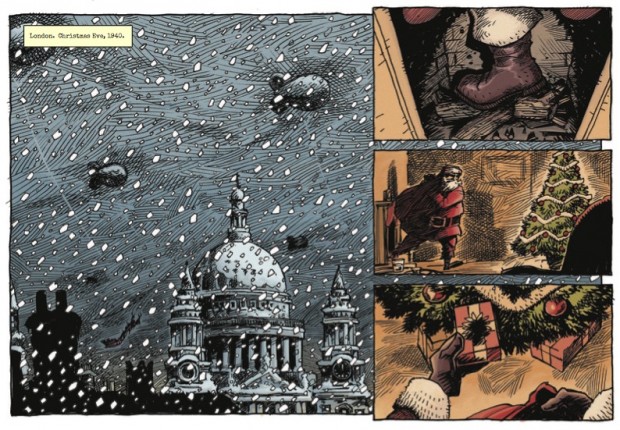
One of things we really liked about Santa Claus vs The Nazis is that you avoid it being too schmaltzy and chocolate boxy, but still manage to get that heart to it with the relationship between Peter and Reggie. Was that a difficult challenge to get that balance right?
BD: Yeah, it went through a few drafts. In fact, the first draft had Reggie and Peter as background comic relief characters. It was an artist friend, Roger Mason, who read it and pointed out that their relationship was the most interesting thing in it. That feedback led me to bring them forward and really focus on them as the heart and soul of the book. I don’t really do sentiment that much in my stories, but I knew that if it was going to be a Christmas book it did really have to have a bit of sentimentality in it – “fascism is bad, kids!” doesn’t really count. I’m really glad you think we judged it right, for me I was just going on instinct!
In the same way, you aren’t afraid to make things a bit dark – we’re thinking about the scenes with the Nazi invasion and the beatings at the beginning. How important was it for you give it that depth in order to make the story work?
BD: I don’t think I’ve ever been afraid of taking my stories to dark places. One of the things that interests me most as a writer is moral complexity – when there actually is no right answer, or situations where what feels right is actually the worst thing you can do. There’s probably less of that in this story than others I’ve written though, simply by virtue of being a comedy. But it’s certainly not light! I think the most potent comedies are ones with something very serious to say, or are dealing with dark subjects. (Dr Strangelove, for example.) Plus my sense of humour is quite dark and dry, and a lot of the comedy that’s in there is there because I came up with something fairly dark, thought “no, that’s just wrong!”, giggled and stuck it in.
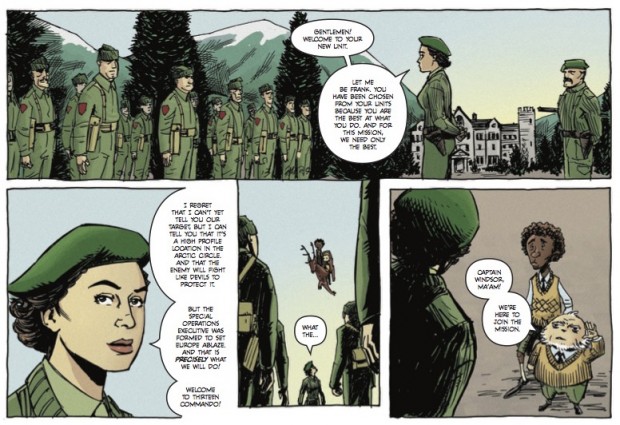
One of our favourite parts of the story is the introduction of Captain Windsor! Were you at all worried about bringing in the Queen as an all action character? Was this always part of the plan or one of those lightbulb moments when you were looking for the right kind of hero?
BD: Is it the Queen? We never mention her name… 🙂
But to answer your question, it was a light-bulb moment that again made me giggle. I loved the idea of taking a royal family member and making her the physical embodiment of Britain’s self image during the war (an iron-cast determination, with a stiff upper-lip). It’s a very positive portrayal I think. The book (and Captain Windsor’s portrayal in particular) draws a lot from the kind of British war movies that were made from the 40s to the 60s, but I was definitely also referencing British war comics – particularly those told in 3 page chapters, as that was the Aces Weekly format. In fact I asked Pat Mills for advice on it, and he was generous enough to pass on some tips.
The art style is quite different to your usual style Gavin, did you consciously adapt your work to better match the style of story? If so what did you change and would you ever return to that style again? Or was it just part of the development of your style, as Aces was produced quite a while ago now, wasn’t it?
GM: It was something that I wanted to give a slight period feel to so I used crosshatching. Lots of it. (The double page spreads are a good example of this) The logic was to loosely emulate etchings but still retain the pulpy comic book look. Along with Miroslav Mrva and Owen Watts on colouring duty, they massively helped to push the pulpy look and really elevated the art. Since the original release in Aces my style has naturally evolved so I don’t know if I would revisit that style again, but I always try to adapt the art to the fit the story and somewhere in there my ‘style’ will come through.
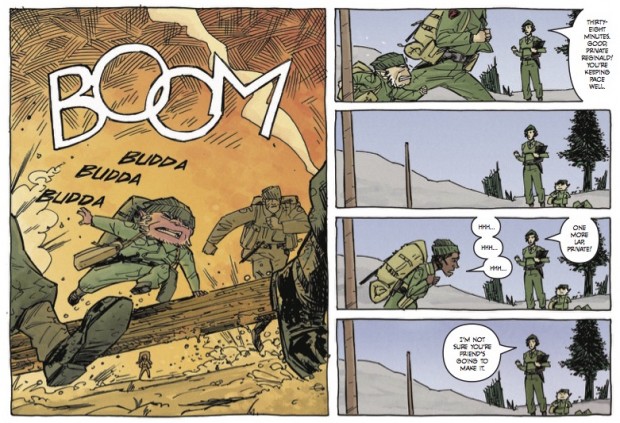
BD: It happened because of a project I’ve been doing with Mick McMahon, called The Kestrels. (It’s on hold at the moment because Mick’s busy storyboarding for Ben Wheatley.) Anyway, David contacted Mick and asked if we wanted to do the book for Aces Weekly. Ultimately we decided against it, but I contacted David and offered him Santa Claus instead. David was pretty hesitant – he wanted Aces to sell in Germany and was worried about causing offence. He ultimately said yes when a German friend of his told him only actual Nazis would be offended by it!
Working with David was (and is) great, he’s been super-supportive of our work. He’s very passionate about comics, and is very keen to help the next generation of creators develop. I would certainly encourage people to not be afraid of talking to him at conventions, he’s very approachable.
GM: When it came to the layout of the art I had already started in the standard comic book format but luckily I was only a page and a half completed when the opportunity to get published in Aces came. I can’t remember if there were any particular challenges to the format (maybe I’m repressing those memories) but it really offered itself to show off big, sweeping landscapes and I was happy to give it a go. Also I was super chuffed to be able to work with David Lloyd, so if the format was interpretive dance I’d have probably gone for that too.
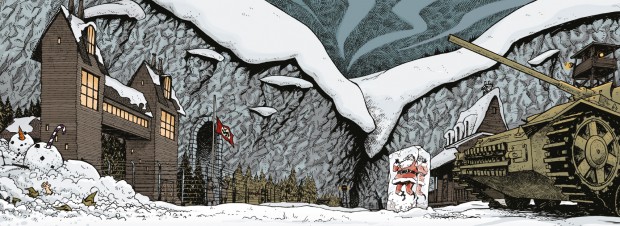
Have you had to make many challenges in changing the format for print? Have Markosia been OK about the book not being portrait?
BD: Yeah, they were OK with it. We did look into converting it to portrait, but it would have lost a lot more than it gained; the artwork simply wasn’t designed to be converted. But we added a few double-page spreads, which I don’t think has actually been done in a landscape book before. I love them – they’re really wide and cinematic…
And finally will you be returning to the world of Santa and co. – perhaps having him take on some other kind of evil force? Santa vs. ISIS? Santa vs. Trump?
BD: It’ll depend on how well this book does, but we’d certainly like Santa to return – in fact we know exactly what the sequel will be. You’ll find the title logo in the back of the book…
You can purchase Santa Claus vs. The Nazis from the Markosia Store for £14.99


